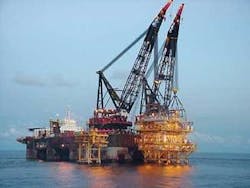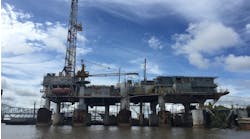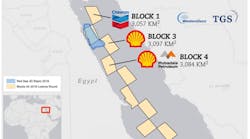Ted Moon, Technology Editor
Anyone who was around to observe Trinidad & Tobago’s offshore hydrocarbon exploration activities in 1954 would most likely not recognize the place in 2006. In the past 52 years, E&P activities have shifted from the production of oil from the Soldado field in the shallow water Gulf of Paria to the production of gas from the island country’s huge reservoirs in the Caribbean Sea and the Atlantic Ocean.
With proven reserves of 990 MMbbl of oil and nearly 26 tcf of gas in 2005, Trinidad & Tobago is by far the largest energy player in the Caribbean. It is therefore no surprise that Trinidad & Tobago’s hydrocarbon industry now plays host to major international oil and service companies from around the world. What follows is a brief rundown of offshore E&P activities from some of these companies.
BG
British Gas Trinidad & Tobago has been in operation since 1989 and currently supplies gas from fields in the East Coast Marine Area (ECMA) to the domestic market and from the North Coast Marine Area (NCMA) to the Atlantic LNG facility, where it is exported to North America. In March 2005, BG reached a milestone of 1 tcf of gross operated gas production in the country.
BG is a 50% shareholder and operator of the ECMA projects Dolphin, Dolphin Deep, and Starfish. Chevron holds the remaining 50% stake. Dolphin is located in block 6(b), 83 km off the east coast of Trinidad, and has been producing since 1996. BG is contractually obligated to supply 275 MMscf/d of gas to the National Gas Company of Trinidad & Tobago from Dolphin. The Dolphin Deep and Starfish discoveries are more recent, and tie into the existing Dolphin platform. Dolphin Deep is a milestone for Trinidad & Tobago, as it is the first subsea completion for the country. Another important discovery is the Manatee-1 well, located in block 6(d) of ECMA and completed in January 2005. This well indicated gross reserves of between 1.3 and 1.6 tcf of gas.
BG also operates the NCMA field, located 40 km off the north cost of Trinidad, and includes the gas fields Hibiscus, Poinsettia, Chaconia, and Ixora. Its partners in the field include state-owned Petrotrin, ENI and PetroCanada. These fields are being developed in up to four phases to supply gas to Trains 2, 3 and 4 of the Atlantic LNG project, a consortium led by BG, BP and Repsol-YPF. NCMA is contracted to supply 240 MMscf/d to Train 2 for up to 20 yrs, 45 MMscf/d to Train 3 and 80 MMscf/d to Train 4.
BHP Billiton
BHP Billiton began exploring offshore Trinidad & Tobago in 1996, under the country’s first production sharing contract. In January 2005, the company started production from the Angostura field, located off Trinidad’s northeast coast in block 2(c) and containing an estimated 310 MMbbl of recoverable oil reserves. BHP is the majority stakeholder (45%) and operator of Angostura, and its partners are Total (30%) and Talisman Energy (25%). While associated gas from the field is currently reinjected, gas commercialization is planned for Angostura’s Phase 2 development, sometime between 2008 and 2014, depending on reservoir performance.
BHP concentrated its 2005 exploration efforts on retention acreage in block 2(c) and block 3(a). The Howler-1 well, located approximately 6 km south of Angostura in block 2(c), encountered a gas column. BHP and its partner in the well, Talisman Energy, are investigating the acreage around Howler-1 for co-development with Angostura Phase 2.
BHP is the operator in a consortium including Talisman Energy, BG and Total (formerly TFE) for exploration activities on block 3(a), a 600 sq km area adjacent to block 2(c) in water depths ranging from 30 to greater than 90 m. The consortium signed a production sharing contract (PSC) with the Ministry of Energy and Energy Industries in April 2003 for the block, and efforts to date have included running a seismic survey on a major portion of the block, and planned drilling of six wells. Three wells were drilled in fiscal year 2004 - Bimurraburra-1, Delaware-1 and Puncheon-1. These wells all encountered hydrocarbons, but evaluation continues to determine commercial viability.
BP
BP has been operating in Trinidad & Tobago since 1961, and produced its first oil there in 1972. BP operates in a partnership under the name BP Trinidad and Tobago (BPTT), and holds a 70% stake (RepsolYPF holds the remaining 30%). The company is currently the largest hydrocarbon producer in the country and controls nearly 50% of total crude production and 67% of all hydrocarbon production.
The company’s marine activities have been focused on the east coast of Trinidad. BPTT has been scaling down its oil production with the selling of its shares in the Teak, Samman and Poui oil fields to Perenco and Neal & Massy Energy in 2005. Even with divestitures like this, BPTT’s hydrocarbon production over the past 3 years has nearly doubled, due largely to its investment in natural gas projects.
Natural gas currently accounts for 90% of BPTT’s total hydrocarbon production, and projects such as Cannonball are designed to give its gas production a further boost. The Cannonball platform came onstream in March 2006, and is located 35 km off the coast of Trinidad in the Mayaro field in water depths of 231 ft. BPTT expects the Cannonball wells to be high gas producers, providing 800 MMscf/d, or about 25% of the company’s pre-Cannonball production in the country.
Canadian Superior Energy
Alberta-based Canadian Superior has made major investments in Trinidad & Tobago in recent years, and it claims these investments are paying off. The company signed a PSC for offshore E&P on block 5(c), also known as the Intrepid block, located approximately 90 km off the eastern coast of Trinidad in the Columbus basin.
Later this year the company will begin to drill in the Intrepid block using theKan Tan VI semisub drilling rig. Based on seismic studies, the company estimates that natural gas reserves on the block could be upwards of 4 tcf. Canadian Superior will be drilling a minimum of 5 wells over the course of the next 3 years.
Chevron
Chevron dates its presence in Trinidad to 1915, when one of its predecessors The Texas Co. first began doing business in the country. Today, Chevron’s presence in the country is mainly focused on it partnership with BG Group, in which it has a 50/50 joint venture at the Dolphin field.
Another 50/50 partnership with BG is the Manatee-1 well in block 6(d), in which Chevron is the operator. In 2005, Chevron drilled Manatee-1 in 299 ft of water and encountered 6 gas sand intervals for a total gross thickness of 899 ft. Work continues to assess the find.
EOG Resources
US-based independent EOG Resources, formerly Enron Oil & Gas Co., has been doing business in Trinidad since 2000, with the signing of a 15-yr contract to supply natural gas to the National Gas Company of Trinidad & Tobago Ltd.
Since then, EOG has expanded its presence off the east coast and increased gas production steadily year on year to supply ammonia plants and Train 4 of the large Atlantic LNG project. The company holds leases on several key pieces of offshore acreage, either alone or partnered with small Trinidadian independent Primera Energy. By the end of 2005, EOG reported gas production of 94 bcfe and reserves of 1.33 tcfe.
Petro-Canada
In 2002, Alberta-based Petro-Canada acquired E&P assets of European Veba Oil & Gas, which included assets in Trinidad & Tobago. Since then, Petro-Canada has signed PSCs for blocks 1(a) and 1(b) in the Gulf of Paria and block 22 off of Tobago, which were awarded in a 2003 licensing round and represent the company’s first operated assets in the country. Seismic survey work is ongoing for these blocks.
Petro-Canada also has a 17.3% working interest in a gas project in NCMA, operated by BG.
Petrotrin
State-owned Petroleum Company of Trinidad & Tobago Ltd. (Petrotrin) was incorporated in 1993 following a series of mergers and acquisitions that began in the mid ‘70s. The company and its business unit Trinmar hold acreage mainly off the western coast in the Gulf of Paria.
Petrotrin controls nearly half of the oil production in the country, and has an increasing interest in gas production, due in part to the government’s recent policy changes for oil and gas E&P. In the updated E&P license model, the government retains a minimum interest of 35% in shallow water and 20% in deepwater for Petrotrin in the event that a production venture is successful. Petrotrin will not incur any exploration costs in these ventures.
Talisman
In addition to its working interest and successes with the Greater Angostura project, Canada’s Talisman Energy Inc. has conducted exploration activities elsewhere off the eastern coast. In 2005, the company completed operations on one unsuccessful well and drilled an unsuccessful exploration well in the exploration portion of block 2(c). Talisman also holds a 30% interest in the PSC on block 3(a), although it has been renegotiating this agreement, which may result in a reduction of its working interest and well commitments. However, Talisman remains very active in the region and continues to bid in subsequent rounds for offshore acreage.
Atkins values local talent for asset integrity services
Atkins values local talent for asset integrity services
Burgeoning offshore activity in Trinidad & Tobago has brought unique opportunities to service companies that have expertise in specialized topics. If these companies expect to thrive in this country, they are expected to contribute to the economy by employing locals whenever and wherever possible. International consultancy group Atkins is a company that has addressed this issue with an intensive training program that is already creating positive results in its brief two-year history.
Atkins’ oil and gas business unit recently brought MSL Engineering into its group, which consults on asset integrity on a worldwide basis to help major producers such as BP keep their installations in service for longer periods.
As Justin Bucknell, director Atkins Americas, explains, “we (MSL) had been working in Trinidad since about 2000, although the work was initially done out of our Houston office. We realized that we had to set up a local office in order to deal with the growth of our business in the Trinidad market.”
When the group first moved into Trinidad, it quickly recognized the pool of raw local talent that it could draw from. “We recruited from the University of West Indies, which has an excellent engineering program,” Bucknell says. “Professor Raymond Charles at the university identified 6 or 7 good local candidates, and of those, we employed 3 in the first year.”
These new employees were then brought to Houston and placed in a training program for a 6-9 month period, where they had the opportunity to learn the niche integrity management skills that the company provides. Under the apprenticeship program, the trainees learned how to conduct equipment inspections, how to diagnose corrosion problems, and how to implement improvements and repairs.
Bucknell says, “At the end of that period we took them back to Trinidad and placed them under the guidance of an experienced expatriate engineer to continue their training.” The group will also have the opportunity to spend time in one of Atkins’ UK offices to learn some of the skill sets available there.
“The program has worked very well for us thus far,” says Bucknell. “The first year trainees have already become useful to us in Trinidad.” This year, an additional 4 Trinidadians were selected from the same university to go through this apprenticeship training program and every indication points to more students in coming years.
The goal for Atkins is to provide a totally self-sustaining unit in Trinidad that works independently on local projects. A tour of the local office shows that the company is already well on its way to self-sufficiency. While there are currently two expatriates in the office, the other workers are from Trinidad, including 2 draftsmen, 2 technicians and an office manager. By the end of this year, Atkins will have a total of 7 trained Trinidadian engineers out of the local office.
As Bucknell states, and as many other international companies can no doubt attest, “Local content is absolutely essential.” What is also essential in such a competitive market is a competent workforce that has learned best practices from a global perspective.




